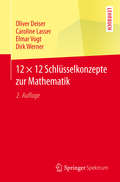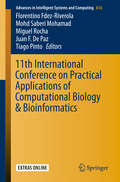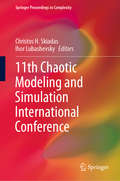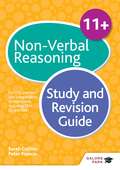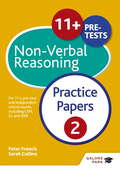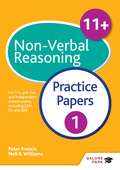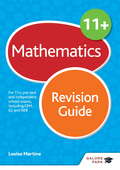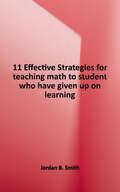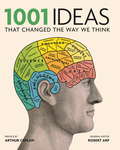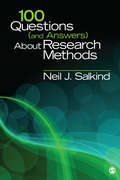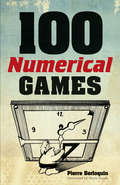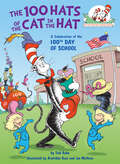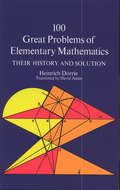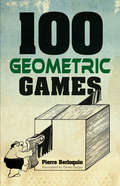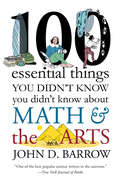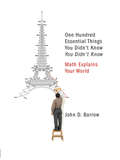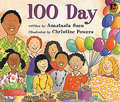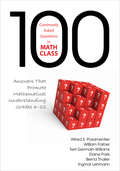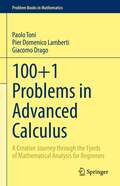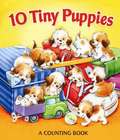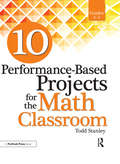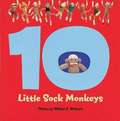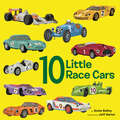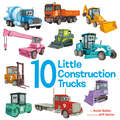- Table View
- List View
12 × 12 Schlüsselkonzepte zur Mathematik
by Oliver Deiser Caroline Lasser Elmar Vogt Dirk WernerWie ist ein Ring definiert, wann kann man Grenzprozesse vertauschen, was sind lineare Ordnungen und wozu benötigt man das Zornsche Lemma in der Linearen Algebra? Das Buch will seinen Lesern helfen, sich in der Fülle der grundlegenden mathematischen Definitionen zurecht zu finden und exemplarische mathematische Ergebnisse einordnen und ihre Eigenheiten verstehen zu können. Es behandelt hierzu je zwölf Schlüsselkonzepte der folgenden zwölf Themengebiete der Mathematik: Grundlagen Zahlen Zahlentheorie Diskrete Mathematik Lineare Algebra Algebra Elementare Analysis Höhere Analysis Topologie und Geometrie Numerik Stochastik Mengenlehre und Logik Ein besonderes Augenmerk liegt auf einer knappen und präzisen, dabei aber nicht zu formalen Darstellung. Dadurch erlauben die einzelnen Beiträge ein fokussiertes Nachlesen ebenso wie ein neugieriges Kennenlernen. Das Buch ist geschrieben für Studierende der Mathematik ab dem ersten Semester und möchte ein treuer Begleiter und eine zuverlässige Orientierungshilfe für das gesamte Studium sein. Die 2. Auflage ist vollständig durchgesehen und um Literaturangaben ergänzt.
11th International Conference on Practical Applications of Computational Biology & Bioinformatics (Advances in Intelligent Systems and Computing #616)
by Florentino Fdez-Riverola Juan F. De Paz Mohd Saberi Mohamad Miguel Rocha Tiago PintoBiological and biomedical research are increasingly driven by experimental techniques that challenge our ability to analyse, process and extract meaningful knowledge from the underlying data. The impressive capabilities of next-generation sequencing technologies, together with novel and constantly evolving, distinct types of omics data technologies, have created an increasingly complex set of challenges for the growing fields of Bioinformatics and Computational Biology. The analysis of the datasets produced and their integration call for new algorithms and approaches from fields such as Databases, Statistics, Data Mining, Machine Learning, Optimization, Computer Science and Artificial Intelligence. Clearly, Biology is more and more a science of information and requires tools from the computational sciences. In the last few years, we have seen the rise of a new generation of interdisciplinary scientists with a strong background in the biological and computational sciences. In this context, the interaction of researchers from different scientific fields is, more than ever, of foremost importance in boosting the research efforts in the field and contributing to the education of a new generation of Bioinformatics scientists. The PACBB'17 conference was intended to contribute to this effort and promote this fruitful interaction, with a technical program that included 39 papers spanning many different sub-fields in Bioinformatics and Computational Biology. Further, the conference promoted the interaction of scientists from diverse research groups and with a distinct background (computer scientists, mathematicians, biologists).
11th Chaotic Modeling and Simulation International Conference (Springer Proceedings in Complexity)
by Christos H. Skiadas Ihor LubashevskyGathering the proceedings of the 11th CHAOS2018 International Conference, this book highlights recent developments in nonlinear, dynamical and complex systems. The conference was intended to provide an essential forum for Scientists and Engineers to exchange ideas, methods, and techniques in the field of Nonlinear Dynamics, Chaos, Fractals and their applications in General Science and the Engineering Sciences. The respective chapters address key methods, empirical data and computer techniques, as well as major theoretical advances in the applied nonlinear field. Beyond showcasing the state of the art, the book will help academic and industrial researchers alike apply chaotic theory in their studies.
11+ Non-Verbal Reasoning Study and Revision Guide: For 11+, pre-test and independent school exams including CEM, GL and ISEB
by Peter Francis Sarah CollinsExam Board: ISEBLevel: 11 PlusSubject: Non-Verbal ReasoningFirst Teaching: September 2016First Exam: Spring 2017Secure the top marks in 11 plus independent school entrance exams and pre-tests and a better chance at getting into their school of choice with this essential study and revision guide. Stretching content ensures that all the Non-Verbal Reasoning skills are thoroughly revised ahead of the exams.- Explains and tests the full range of question types and skills met in Non-Verbal Reasoning in exams- Prepares pupils for a wide range of independent school exams and pre-tests with challenging extension material- Builds on existing knowledge with clear cross-curricular links to English- Features helpful insight in to the exams, with examples, practical tips and advice- Prepares pupils for exam conditions with timed and levelled exam-style questions- Identifies strengths and weaknesses using 11 plus sample tests with detailed answer guidanceAlso available for 11 Plus Verbal Reasoning preparation: - Non-Verbal Reasoning Workbook Age 8-10 - Non-Verbal Reasoning Workbook Age 9-11 - Non Verbal Reasoning Workbook Age 10-12 - 11+ Non- Verbal Reasoning Practice Papers 1&2Revision Guides, Workbooks and Practice Papers are also available for Maths, English, Science and Verbal Reasoning on www.galorepark.co.uk
11+ Non-Verbal Reasoning Practice Papers 2: For 11+, pre-test and independent school exams including CEM, GL and ISEB
by Peter Francis Sarah CollinsPrepare for the most challenging of pre-tests and 11+ independent school entrance exams with six levelled exam papers designed to test pupils' skills in Non-Verbal Reasoning exams for a better chance at getting into their school of choice. - Develops and perfects exam technique for all major pre-test and 11+ independent school exams including CEM, GL and ISEB- Features levelled papers to help build skills for the top marks - Teaches pupils to improve their response rates with timed papers- Builds exam-room confidence by practising with a variety of exam paper styles- Identifies weaker areas and improves results with detailed answers and commentaryAlso available for 11+ Non-Verbal Reasoning preparation: · 11+ Non-Verbal Reasoning Revision Guide ISBN xxx· Non-Verbal Reasoning Workbook Age 8-10 ISBN xxx· Non-Verbal Reasoning Workbook Age 9-11 ISBN xxx· Non-Verbal Reasoning Workbook Age 10-12 ISBN xx Revision Guides, Workbooks and Practice Papers are also available for Maths, English, Science and Verbal Reasoning on www.galorepark.co.uk.
11+ Non-Verbal Reasoning Practice Papers 1: For 11+, pre-test and independent school exams including CEM, GL and ISEB
by Neil R Williams Peter Francis Sarah CollinsExam Board: ISEBLevel: 11 PlusSubject: Non-Verbal ReasoningFirst Teaching: September 2016First Exam: Spring 2017Practice exam papers to prepare children for the most challenging of pre-tests and 11 plus independent school entrance exams. Includes 9 levelled exam papers that will test pupils' skills in Non-Verbal Reasoning.- Develops exam techniques tested in all major pre-tests and 11 plus independent school examinations including CEM, GL and ISEB- Features papers written to measured levels of difficulty to help build skills- Teaches pupils to improve their response rates with timed papers- Builds exam-room confidence by practicing with a variety of exam paper styles- Identifies weaker areas and improves results with detailed answers and commentaryAlso available for 11 Plus Non-Verbal Reasoning preparation: - 11 Plus Non-Verbal Reasoning Revision Guide- Non-Verbal Reasoning Workbook Age 8-10- Non-Verbal Reasoning Workbook Age 9-11- Non-Verbal Reasoning Workbook Age 10-12
11+ Maths Revision Guide: For 11+, pre-test and independent school exams including CEM, GL and ISEB
by Louise MartineExam Board: ISEBLevel: 11 PlusSubject: MathsFirst Teaching: September 2015First Exam: Autumn 2016Secure the top marks in 11 plus independent school entrance exams and Pre-Tests leading to a better chance at getting into the school of choice with this essential revision guide. Complete coverage of the ISEB 11 Plus Maths syllabus and stretching extra content ensures that every topic is thoroughly revised ahead of the exams.This book covers everything required for the 11 Plus Maths exam- Prepares pupils for a wide range of independent school exams and pre-tests with challenging extension material- Consolidates revision with all the key information in one place- Features helpful insight in to the exams, with examples, practical tips and advice- Tests understanding and technique with timed, levelled exam-style questionsAlso available for 11 Plus Maths preparation: - 10-Minute Maths Tests Workbook Age 8-10 9781471829611- 10-Minute Maths Tests Workbook Age 9-11 9781471829635- Mental Arithmetic Workbook Age 8-10 9781471829505- Mental Arithmetic Workbook Age 9-11 9781471829628Revision Guides, Workbooks and Practice Papers are also available for English, Science, Verbal Reasoning and Non-Verbal Reasoning on www.galorepark.co.uk
11 Effective Strategies for Teaching Math to Students Who Have Given Up on Learning
by Jordan B. SmithAs a special needs teacher, your time is already limited. From meetings to paperwork, there is little time left for actual teaching. Do you really have time to do more? These 11 strategies aren’t about doing more. It’s about getting the most out of your students most effectively and practically. They will enable students to develop a deep love of math and skills they can take with them for other subjects and into adulthood. No matter the level of despondency among your students, "11 Effective Strategies for Teaching Math to Students Who Have Given Up on Learning" equips you with the tools to revitalize your passion for math. Turn your classroom into a dynamic hub of exploration and discovery, and witness the joy of learning rekindled among your students. If you're ready to transform your math teaching journey and empower every student to succeed, this book adds to your collection of math teaching books.
1001 Ideas that Changed the Way We Think (1001)
by Robert ArpAn awe-inspiring overview of the development of human knowledge over the centuries!Part of the highly successful '1001' series which have sold over a million copies in the UK alone 1001 Ideas That Changed The Way We Think offers not only a comprehensive history of ideas, but also an eminently browsable source of amusement.This richly informative and entertaining book provides a wide variety of answers to those eternal questions such as...How was the universe created and what is the place of humans within it? How should a person live? And how can we build a just society?Readers will discover how the Greek philosopher Zeno 'proved' a flying arrow never moves and the mathematical proof of the existence of life in other galaxies. The inspiring ideas explored range from Gandhi's theory of civil disobedience to Mary Wollstonecraft's groundbreaking advocacy of women's rights. A wide variety of cultural movements are also covered, including Neoclassicism, Surrealism and Postmodernism.Drawing of a wide spectrum of topics including politics, cosmology, the arts, philosophy and religious beliefs, 1001 Ideas That Changed The Way We Thinktraces the exponential growth of human knowledge across the centuries. Ranging from the ancient wisdom of Confucius and Plato, to the cutting-edge theories taking shape in the twenty-first century, this book offers a wealth of stimulation and wit for any reader with a lively and curious mind.
100 Questions (SAGE 100 Questions and Answers)
by Neil J. Salkind"How do I create a good research hypothesis?""How do I know when my literature review is finished?""What is the difference between a sample and a population?""What is power and why is it important?"In an increasingly data-driven world, it is more important than ever for students as well as professionals to better understand the process of research. This invaluable guide answers the essential questions that students ask about research methods in a concise and accessible way.
100 Numerical Games
by Martin Gardner Pierre Berloquin Denis DugasFollow the hour hand and minute hand of a clock for 24 hours. How many times do they form a right angle?Timothy's house has several rooms, each of which has an even number of doors, including doors that lead outside. Is the number of outside doors even or odd?Stimulating and delightful, this collection of puzzles features original and classic brainteasers. The author, a puzzle columnist for Le Monde, specially selected these mind-benders for the widest possible audience, ensuring that they're neither too hard for those without a math background nor too easy for the mathematically adept. All puzzles are clearly stated and accurately answered at the back of the book - and they're great fun to consider, whether you crack them or not. Includes a Foreword by Martin Gardner.
The 100 Hats of the Cat in the Hat: A Celebration of the 100th Day of School (Cat in the Hat's Learning Library)
by Tish RabeA Seussian celebration of simple math concepts—perfect for the 100th Day of School and fans of The Cat in the Hat!The Cat in the Hat spends the 100th Day of School visiting Sally and Dick's classroom to show how some simple tools—including a hundreds chart, ten frame, number line, and 100 silly hats—make it easy and fun to count, add, subtract, multiply, and divide.While this is a natural choice for celebrating the 100th Day of School, The 100 Hats of the Cat in the Hat is perfect for anyone, anytime, who wants to nurture a beginning reader's interest in numbers! Fans of the hit PBS show The Cat in the Hat Knows a Lot About That! will be delighted at this new addition to the Learning Library series.
100 Great Problems of Elementary Mathematics
by Heinrich Dörrie"The collection, drawn from arithmetic, algebra, pure and algebraic geometry and astronomy, is extraordinarily interesting and attractive." -- Mathematical GazetteThis uncommonly interesting volume covers 100 of the most famous historical problems of elementary mathematics. Not only does the book bear witness to the extraordinary ingenuity of some of the greatest mathematical minds of history -- Archimedes, Isaac Newton, Leonhard Euler, Augustin Cauchy, Pierre Fermat, Carl Friedrich Gauss, Gaspard Monge, Jakob Steiner, and many others -- but it provides rare insight and inspiration to any reader, from high school math student to professional mathematician. This is indeed an unusual and uniquely valuable book.The one hundred problems are presented in six categories: 26 arithmetical problems, 15 planimetric problems, 25 classic problems concerning conic sections and cycloids, 10 stereometric problems, 12 nautical and astronomical problems, and 12 maxima and minima problems. In addition to defining the problems and giving full solutions and proofs, the author recounts their origins and history and discusses personalities associated with them. Often he gives not the original solution, but one or two simpler or more interesting demonstrations. In only two or three instances does the solution assume anything more than a knowledge of theorems of elementary mathematics; hence, this is a book with an extremely wide appeal.Some of the most celebrated and intriguing items are: Archimedes' "Problema Bovinum," Euler's problem of polygon division, Omar Khayyam's binomial expansion, the Euler number, Newton's exponential series, the sine and cosine series, Mercator's logarithmic series, the Fermat-Euler prime number theorem, the Feuerbach circle, the tangency problem of Apollonius, Archimedes' determination of pi, Pascal's hexagon theorem, Desargues' involution theorem, the five regular solids, the Mercator projection, the Kepler equation, determination of the position of a ship at sea, Lambert's comet problem, and Steiner's ellipse, circle, and sphere problems.This translation, prepared especially for Dover by David Antin, brings Dörrie's "Triumph der Mathematik" to the English-language audience for the first time.
100 Geometric Games
by Martin Gardner Pierre Berloquin Denis DugasThere are three loops in a tangle of rope. How many are independent, and how many are interlocked?Two knights stand on a chessboard. How many other knights must you add so that each square is occupied or threatened by a knight?Among six seemingly identical drawings of mandalas, each rotated by multiples of 60 degrees, one is different. Which is it, and why?Challenge yourself with these mind-benders, brainteasers, and puzzles. Each of them has been carefully selected so that none will be too tough for anyone without a math background - but they're not too easy. Some are original, and all are clearly and accurately answered at the back of the book.
100 Essential Things You Didn't Know You Didn't Know about Math and the Arts
by John D. BarrowA fascinating exploration of math's connection to the arts. At first glance, the worlds of math and the arts might not seem like comfortable neighbors. But as mathematician John D. Barrow points out, they have a strong and natural affinity--after all, math is the study of all patterns, and the world of the arts is rich with pattern. Barrow whisks us through 100 thought-provoking and often whimsical intersections between math and many arts, from the golden ratios of Mondrian's rectangles and the curious fractal-like nature of Pollock's drip paintings to ballerinas' gravity-defying leaps and the next generation of monkeys on typewriters tackling Shakespeare. For those of us with our feet planted more firmly on the ground, Barrow also wields everyday equations to reveal how many guards are needed in an art gallery or where you should stand to look at sculptures. From music and drama to literature and the visual arts, Barrow's witty and accessible observations are sure to spark the imaginations of math nerds and art aficionados alike.
100 Essential Things You Didn't Know You Didn't Know: Math Explains Your World
by John D. Barrow"Where else does math become a romp, full of entertaining tricks and turns?"--Bryce Christensen, Booklist Have you ever considered why you always get stuck in the longest line? Why two's company but three's a crowd? Or why there are six degrees of separation instead of seven? In this hugely informative and endlessly entertaining book, John D. Barrow takes the most baffling of everyday phenomena and--with simple math, lucid explanations, and illustrations--explains why they work the way they do. His witty, crystal-clear answers shed light on the dark and shadowy corners of the physical world we all think we understand so well.
100 Day
by Anastasia Suen Christine Powers<p>A class of kindergarten children celebrate the 100th day of school. <p>Guided Reading: C; Interest Level: Grades 1 - 1; Reading Level: Grades 1 - 1; Themes: Comparing/Classifying/Measuring, Counting Money/Everyday Math, Classroom Activities, Multi-ethnic interest, Games/Toys, Education, Cultural Diversity, Childhood Experiences and Memories, Beginning Concepts, Realistic Fiction, Collaboration
100 Commonly Asked Questions in Math Class: Answers That Promote Mathematical Understanding, Grades 6-12
by Alfred S. Posamentier William L. Farber Terri L. Germain-Williams Elaine S. Paris Bernd Thaller Ingmar H. Lehmann100 ways to get students hooked on math! That one question got you stumped? Or maybe you have the answer, but it’s not all that compelling. Al Posamentier and his coauthors to the rescue with this handy reference containing fun answers to students’100 most frequently asked math questions. Even if you already have the answers, Al’s explanations are certain to keep kids hooked. The big benefits? You’ll discover high-interest ways to Teach to the Common Core’s math content standards Promote inquiry and process in mathematical thinking Build procedural skills and conceptual understanding Encourage flexibility in problem solving Emphasize efficient test-taking strategies
100+1 Problems in Advanced Calculus: A Creative Journey through the Fjords of Mathematical Analysis for Beginners (Problem Books in Mathematics)
by Paolo Toni Pier Domenico Lamberti Giacomo DragoThis book convenes a collection of carefully selected problems in mathematical analysis, crafted to achieve maximum synergy between analytic geometry and algebra and favoring mathematical creativity in contrast to mere repetitive techniques. With eight chapters, this work guides the student through the basic principles of the subject, with a level of complexity that requires good use of imagination.In this work, all the fundamental concepts seen in a first-year Calculus course are covered. Problems touch on topics like inequalities, elementary point-set topology, limits of real-valued functions, differentiation, classical theorems of differential calculus (Rolle, Lagrange, Cauchy, and l’Hospital), graphs of functions, and Riemann integrals and antiderivatives. Every chapter starts with a theoretical background, in which relevant definitions and theorems are provided; then, related problems are presented. Formalism is kept at a minimum, and solutions can be found at the end of each chapter.Instructors and students of Mathematical Analysis, Calculus and Advanced Calculus aimed at first-year undergraduates in Mathematics, Physics and Engineering courses can greatly benefit from this book, which can also serve as a rich supplement to any traditional textbook on these subjects as well.
10 Performance-Based Projects for the Math Classroom: Grades 3-5
by Todd StanleyEach book in the 10 Performance-Based Projects series provides 10 ready-made projects designed to help students achieve higher levels of thinking and develop 21st-century skills. Projects are aligned to the Common Core State Standards, allowing students to explore and be creative as well as gain enduring understanding. Each project represents a type of performance assessment, including portfolios, oral presentations, research papers, and exhibitions. Included for each project is a suggested calendar to allow teacher scheduling, mini-lessons that allow students to build capacity and gain understanding, as well as multiple rubrics to objectively assess student performance. The lessons are presented in an easy-to-follow format, enabling teachers to implement projects immediately.Grades 3-5
10 Little Sock Monkeys
by Harriet ZiefertTen little monkeys are swinging on a bar. Two by two, these creatures drop away, while all the rest continue to play.
10 Little Race Cars (10 Little Vehicles)
by Annie BaileyFans of cars and trucks can count down from ten to one as they follow ten classic race cars zooming around the track. This sturdy board book is perfect for the youngest readers!Ten little race cars ready to compete.Time for some fun—Brummmm! Crowd is on their feet.It's the car race of the century! On each page of this action-packed board book, young readers can count down race cars from ten to one. Along the way, motorsport fans will spot cars inspired by some of the legends of the history of racing, including the Porsche 917, Lancia Stratos, McLaren MP4/4, and Bugatti Type 35. With noisy words on every page, this is the perfect book to read aloud with your little race car fan.Also available:10 Little Tractors10 Little Excavators10 Little Construction Trucks
10 Little Construction Trucks (10 Little Vehicles)
by Annie BaileyFans of cars and trucks can count down from ten to one as they follow ten construction vehicles on a busy workday. This sturdy board book is perfect for the youngest readers!Ten little construction trucks excited for the day. They can&’t wait to get to work, but something&’s in their way!On each page of this exciting board book, young readers can count down construction vehicles from ten to one. Along the way, they'll learn about different machines on a construction site, such as bulldozers, rollers, forklifts, and concrete mixers. With action on every page, this is the perfect book to read aloud with your little vehicle fan.Also available:10 Little Tractors10 Little Excavators10 Little Race Cars
1 Mississippi 2 Mississippi: A Mississippi Number Book
by Michael Shoulders1 Mississippi, 2 Mississippi is a fitting follow-up to its companion state alphabet book. This fun, colorful, and superbly informative book teaches children about numbers using recognizable places, events, and facts from their respective states. Numbers throughout the books are explained with simple rhyme for younger children and are accompanied by detailed expository text for older learners.
